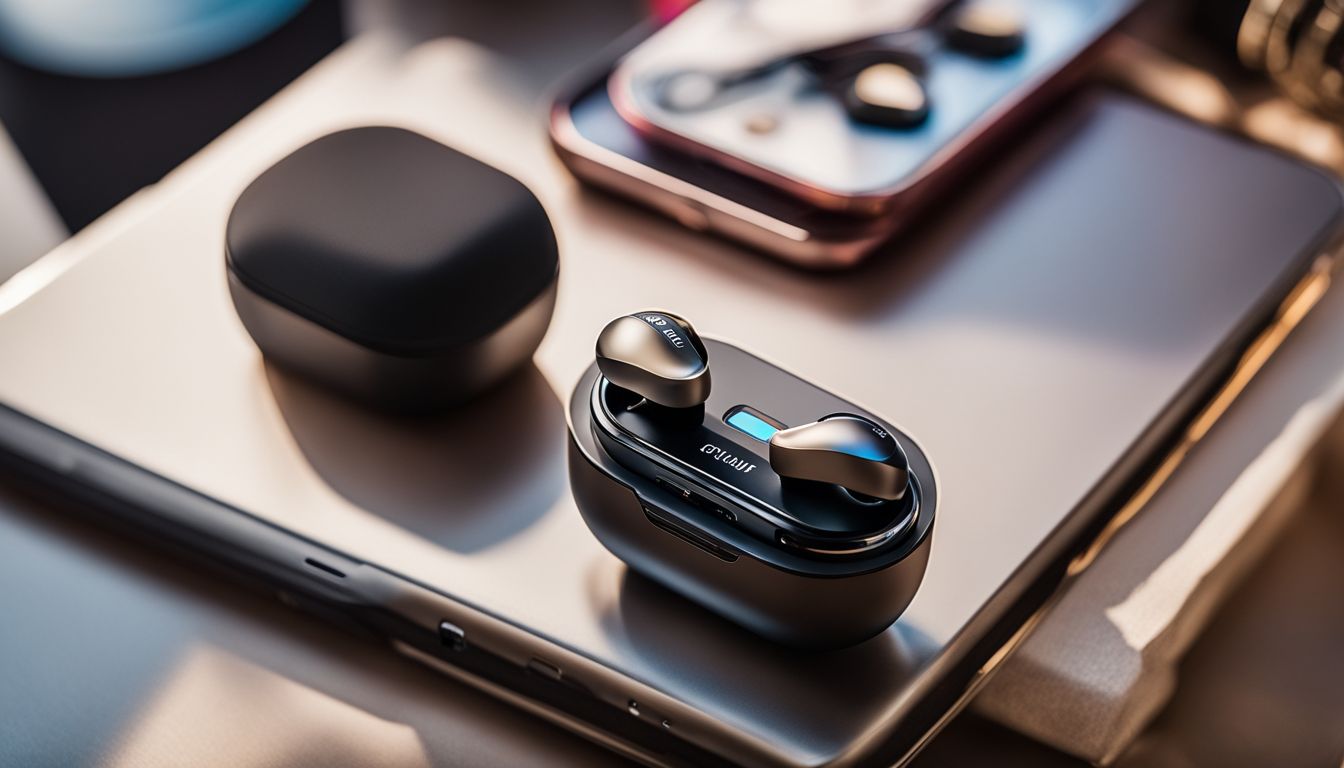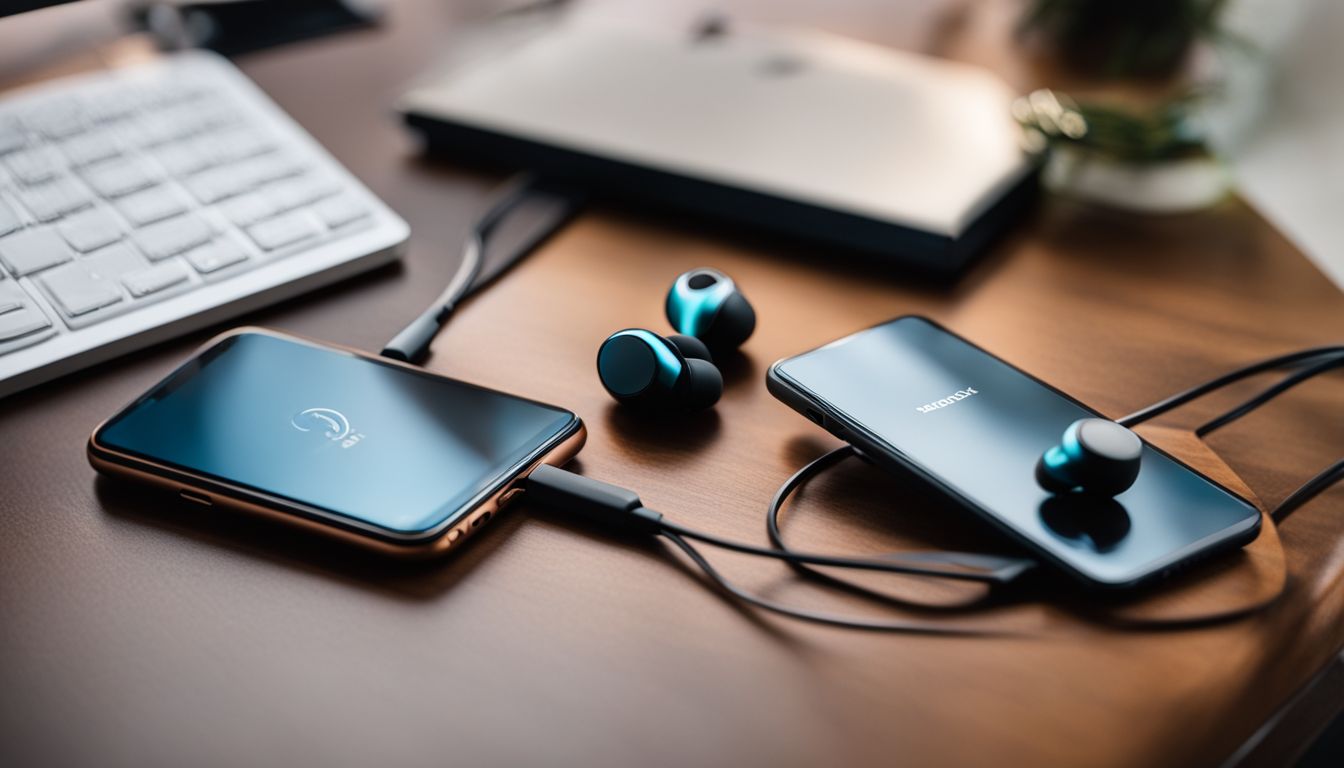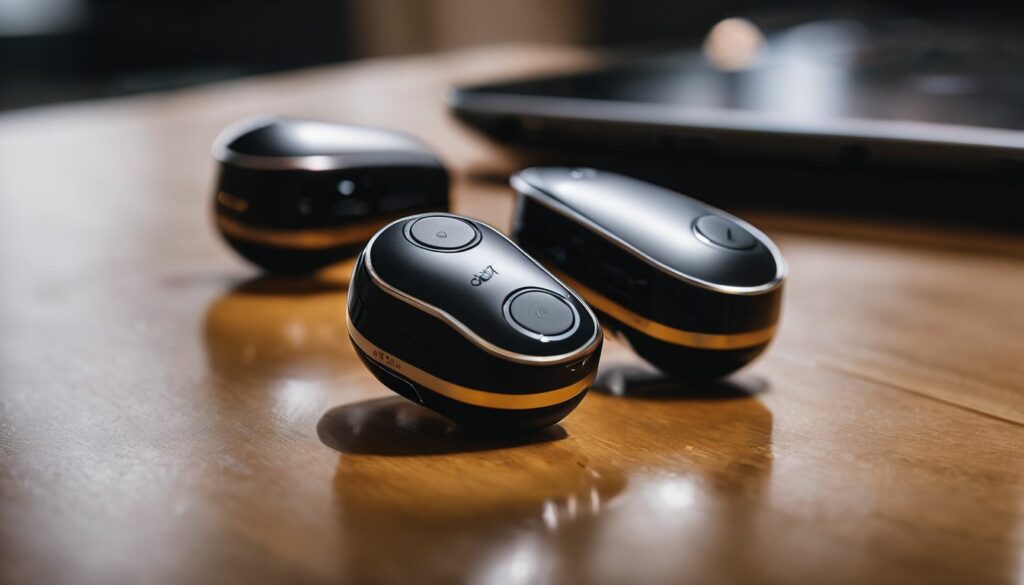- How to Choose Running Shoes for Different Terrains - January 2, 2024
- Improving Your Running Form: A Guide for Beginners - January 2, 2024
- The Science Behind Cushioning in Running Shoes - January 2, 2024
Last Updated on
Struggling with uncomfortable wireless earbuds? You are not alone. An estimated 1 in 5 people find their wireless earbuds don’t fit right or feel comfortable. This article delves into the fascinating science behind comfy, user-friendly wireless earbuds and reveals how innovative technology and ergonomic design come together to cater to your distinct convenience needs.
Let’s get your ears in their comfort zone!
Key Takeaways
- Wireless earbuds work by transmitting sound waves through radio frequency and utilize components such as portable headphone speakers for audio output.
- Comfort is crucial in wireless earbuds, and factors like ergonomics, user satisfaction, ear canal size and shape, cushioning, noise isolation, weight distribution, and adjustable fit all contribute to a comfortable wearing experience.
- Manufacturers incorporate features like secure fit options, different-sized ear tips, ergonomic designs, consideration of individual ear dimensions, cushioned surfaces, lightweight designs, and minimal contact points to optimize comfort in wireless earbuds.
How Do Wireless Earbuds Work?

Wireless earbuds work by transmitting sound waves through radio frequency and utilizing components such as portable headphone speakers for audio output.
Transmission of sound waves through radio frequency
Radiofrequency sets the foundation for wireless headphones’ core functionality. In simple terms, your favorite music travels as sound waves through the air on a journey from your device to the earbuds nestled in your ears.
The magic begins with Bluetooth technology, using short-wavelength ultra-high-frequency (UHF) radio waves to carry these sound waves seamlessly. These carrier frequencies typically range between 2.400 GHz and 2.485 GHz – just right for transmitting data without interruptions or interference.
This transmission process, known as modulation, carries data from audio sources to wireless headphones ready and waiting to decode them into clear sounds you can enjoy anywhere, anytime! Moreover, true wireless earphones employ this technology at its best to provide smooth communication between the audio source and each earbud making up the pair.
Components of portable headphone speakers
Portable headphone speakers play a crucial role in sound reproduction in wireless earbuds. Here are some of their main components:
- Electroacoustic transducers: These components convert the electrical signals into sound waves, allowing you to hear your favorite tunes.
- Signal processing system: This part takes care of converting audio transmission from the source device into electrical signals.
- Bluetooth technology: The integral part that enables wireless connectivity between your device and your earbuds.
- Small Batteries: Tiny power sources are packed within each earbud to facilitate sound reproduction and Bluetooth connections.
- Sound quality enhancers: Certain advanced models incorporate features aimed at improving overall audio delivery for a superior listening experience.
- Magnetic retention: A mechanism embedded within most modern earbuds to facilitate easy storage and reduce the risk of loss or misplacement.
Wireless pairing and charging
Modern earbuds rely on Bluetooth technology for wireless pairing with devices. This system connects your earbuds to any compatible audio source, such as a smartphone or laptop. Once the initial setup is complete, your device will automatically recognize the earbuds whenever they are nearby and powered on.
For charging convenience, many models come with cases that serve as portable chargers. These cases store extra power so you can recharge your earbuds on the go.
Deep Dive: What are Wireless Earbuds and How Do They Work??

Wireless earbuds are portable speakers that fit inside your ears and connect to audio devices using Bluetooth technology. These small, in-ear headphones have become popular due to their convenience and portability.
When turned on or taken out of the charging case, wireless earbuds automatically connect with nearby devices. They use radio frequency to transmit sound waves wirelessly, eliminating the need for cords or cables.
The components inside wireless earbuds include portable headphone speakers and a Bluetooth system that allows for seamless pairing and connectivity. With advancements in technology, researchers are even exploring neural sensing capabilities in wireless earbuds, which could detect brain signals and relay data back to smartphones via Bluetooth.
Overall, wireless earbuds provide a comfortable listening experience while harnessing the power of wireless audio technology.
The Importance of Comfort in Wireless Earbuds
Comfort is a vital aspect of wireless earbuds, ensuring a pleasant listening experience. Discover the factors that influence comfort and see why it’s crucial to consider when choosing your next pair of wireless earbuds.
Factors affecting comfort
Several factors can affect the comfort of wireless earbuds, including:
- Ergonomics: The design and shape of the earbuds impact how they fit in the ear canal.
- User satisfaction: The overall experience and satisfaction level of users can determine the comfort of wearing wireless earbuds.
- Ear canal: The size and shape of an individual’s ear canal can influence the fit and comfort of the earbuds.
- Cushioning: The presence of soft cushioning or padding on the earbuds can provide additional comfort during prolonged use.
- Noise isolation: Effective noise isolation can contribute to a more comfortable listening experience by reducing external distractions.
- Weight distribution: Proper weight distribution in wireless earbuds prevents discomfort caused by uneven pressure on the ears.
- Earbud tips: Different sizes and materials of earbud tips allow for customization and a secure fit that enhances comfort.
- Ear fatigue: Factors such as extended wear time or high sound pressure levels can lead to ear fatigue, reducing overall comfort.
- Adjustable fit: Wireless earbuds with adjustable features like adjustable hooks or different-sized tips provide greater customization for individual comfort preferences.
- Ear sensitivity: Individuals with sensitive ears may require specific design features or materials to ensure optimal comfort during use.
Role of ear dimensions
Ear dimensions play a crucial role in the comfort of wireless earbuds. The shape of our ears and the size of our ear canals vary from person to person, which means that a one-size-fits-all approach may not work for everyone.
When choosing wireless earbuds, it is important to consider ergonomics and find a design that offers a comfortable wearing experience. Factors such as secure fit, earbud design, and user comfort should be taken into account to ensure maximum satisfaction.
Manufacturers often provide different sizes or customizable options to cater to various ear dimensions, allowing users to find the perfect fit for their individual needs. By considering ear dimensions when selecting wireless earbuds, you can enhance your listening experience and enjoy long-lasting comfort throughout the day.
Product attributes for a comfortable fit
Wireless earbuds offer a range of product attributes that contribute to a comfortable fit. These attributes include:
- Secure fit: Many models of wireless earbuds come with features like adjustable ear hooks or wing tips that help keep the buds securely in place during activities.
- Ear tip options: Different sizes and shapes of ear tips are often provided, allowing users to find the most comfortable option for their ears.
- Wearing comfort: The design of wireless earbuds takes into account factors like weight distribution, ergonomics, and materials used to ensure maximum comfort during extended wear.
- Ear dimensions: Studies have shown that considering variations in ear dimensions can enhance the overall comfort of wireless earbuds.
- Product attributes: Companies like Sony, Apple, Samsung, and others prioritize comfort by incorporating cushioned surfaces, lightweight designs, and minimal contact points for less pressure on the ears.
Understanding the Claims of Manufacturers
Manufacturers often claim that their wireless earbuds have features like magnetic retention, seamless wireless pairing, and convenient charging capabilities.
Magnetic retention of earbuds
Wireless earbuds are becoming more popular, and many manufacturers claim to have innovative features that enhance their functionality. One such feature is the magnetic retention of earbuds.
This technology uses magnets embedded in the earpieces to securely hold them together when not in use. For example, Apple’s AirPods utilize this magnetic attachment technology. When you’re not wearing your earbuds, they can easily stick together thanks to the magnets, preventing them from getting tangled or lost.
This magnetic connection provides convenience and peace of mind for users, ensuring that their wireless earbuds are always within reach when needed.
In addition to keeping the earbuds together, magnet-based earphone retention systems also help with automatic pairing and powering on/off functions. By separating the magnets when you take out your buds from their case or break apart during usage triggers a signal for pairing with your device; similarly rejoining them turns off or puts them into standby mode conserving battery life.
Magnetic retention not only enhances the user experience but also adds practicality and efficiency to wireless headphones by providing a seamless solution for securing and using these devices without hassle.
Wireless pairing and charging capabilities
Wireless earbuds have revolutionized the way we listen to music or take calls on the go. With their wireless pairing and charging capabilities, these earbuds offer convenience like never before.
No more dealing with tangled cords or searching for a charger – simply place them in their charging case, and they will automatically start charging. Many manufacturers, like Apple with their Airpods, prioritize this technology, ensuring a seamless wireless experience for users.
So whether you’re syncing them to your device or keeping them powered up throughout the day, wireless earbuds make it easy with their efficient pairing and charging capabilities.
The Truth about Battery Life and Longevity
Small batteries in wireless earbuds often lead to shorter lifespans, sacrificing longevity for the convenience of a compact design.
Impact of small batteries on lifespan
Small batteries have a significant impact on the lifespan of wireless earbuds. Due to their limited size, these batteries degrade over time, resulting in shorter battery life for the earbuds.
Most wireless earbuds use lithium-ion batteries, which typically deliver around 300 cycles before experiencing degradation. In comparison, modern smartphones require at least 800 cycles.
This means that wireless earbuds may need to be replaced or have their batteries replaced within two to three years, resulting in increased electronic waste. The short life cycle of these small batteries highlights the need for innovation in reducing e-waste and improving battery longevity in wearable devices like wireless earbuds.
Sacrificing longevity for convenience
Wireless earbuds offer a convenient and hassle-free listening experience, but this convenience comes at a cost. One trade-off is sacrificing the longevity of the battery. Wireless earbuds have limited battery lifespan, which means they won’t last as long as traditional wired headphones.
Battery degradation is a common issue that affects the performance of wireless earbuds over time. When keeping the battery at a high charge voltage for extended periods, it can cause stress to the battery and reduce its overall lifespan.
To prolong the life of wireless earbud batteries, experts recommend mid-state-of-charge cycling, which involves charging them between 20% and 80%. By finding a balance between convenience and longevity, users can get the most out of their wireless earbuds while ensuring they don’t sacrifice too much in terms of durability.
Conclusion: Balancing Comfort and Technology in Wireless Earbuds
Wireless earbuds have revolutionized the way we listen to music, providing convenience and freedom of movement. But what makes them truly comfortable? The science behind comfortable wireless earbuds lies in their ergonomic design and the careful consideration of factors like ear dimensions and product attributes.
By striking a balance between comfort and technology, manufacturers strive to create earbuds that not only deliver exceptional sound quality but also provide a snug and pleasant fit for extended periods of use.
FAQs
1. How do wireless earbuds stay comfortable in the ears?
Wireless earbuds stay comfortable in the ears due to their lightweight design, ergonomic shape, and adjustable ear tips that provide a secure and personalized fit.
2. Can I wear wireless earbuds for long periods without discomfort?
Yes, you can wear wireless earbuds for long periods without discomfort as they are designed with soft materials and balanced weight distribution to reduce pressure on the ears.
3. How do wireless earbuds prevent falling out during physical activities?
Wireless earbuds prevent falling out during physical activities through features like in-ear hooks or wings that provide extra stability, as well as sweat-resistant materials that help them stay in place.
4. Do wireless earbuds cause any harm to the ears?
No, wireless earbuds do not cause harm to the ears when used properly. They are designed to emit sound at safe volumes and distances from the eardrums.
5. What technologies are used in wireless earbuds to enhance comfort?
Technologies such as advanced acoustics, noise cancellation algorithms, and smart sensors are incorporated into wireless earbuds to optimize audio quality while minimizing discomfort caused by external sounds or poor fit.

